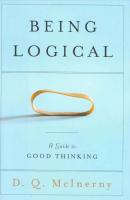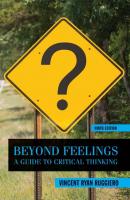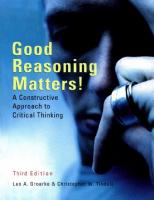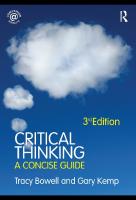
- Author / Uploaded
- D.Q. McInerny
Being Logical: A Guide to Good Thinking
w HETHER REGARDED AS A SCIENCE, A N ART, or a skill-and it can properly be regarded as all three-logic is the basis o
3,183 729 5MB
Pages 159 Page size 432 x 663.12 pts Year 2006
Recommend Papers
File loading please wait...
Citation preview
w
HETHER REGARDED AS A SCIENCE, A N ART,
or a skill-and it can properly be regarded as all
three-logic is the basis of our ability to think, analyze. argue, and communicate. Indeed, logic goes to the very core of what we mean by human intelligence. In this concise, crisply readable book. Professor D.
I
Q. Mclnerny
offers an indispensable guide to using logic to advantage in everyday life. Written explicitly for the layperson. McInerny's Being Logical promises to take its place beside Strunk and White's The Elements ofstyle as a classic of ' lucid, invaluable advice.
As McInerny notes,
logic is a field with a pro-
found bearing on our lives. A mastery of logic begins with an understanding of right reasoning-and encompasses a grasp of the kinship between logical thought and logical expression, a knowledge of the basic terms of argument, and a familiarity with the pitfalls of illogical thinking. Accordingly, McInerny structures his book as a series of brief chapters that build on one another to form a coherent introduction to dear and effective reasoning. At the heart of the book is a consideration of argument-how an argument is founded and elaborated. how it differs from other forms of intellectual discourse, and how it embodies the elements of logic. McInerny teases out the subtleties and complexities of premises and conclusions, differentiates statements of fact from statements of value, and discusses the principles and uses of every major type of argument, from the syllogistic to the conditional. In addition, he provides an incisive look at illogical thinking and explains how to recognize and avoid the most common errors of logic.
BEING
LOGICAL
Being Logical A GUIDE to GOOD T H I N K I N G
D. Q. Mclnerny
RANDOM
H O U S E
i^MMl
NEW
YORK
Copyright © 2004 by D. Q. Mclnerny All rights reserved under International and Pan-American Copyright Conventions. Published in the United States by Random House, an imprint of The Random House Publishing Group, a division of Random House, Inc., New York, and simultaneously in Canada by Random House of Canada Limited, Toronto. RANDOM HOUSE and colophon are registered trademarks of Random House, Inc. LIBRARY OF C O N G R E S S CATALOGING-IN-PUBLICATION DATA
Mclnerny, D. Q. Being logical: a guide to good thinking / D. Q. Mclnerny. p. cm. Includes bibliographical references. ISBN 1-4000-6171-7 1. Logic. 2. Reasoning. 3. Thought and thinking. I. Title. BC71.M37 2004 160—dc22 2003058779 Text design by Mary A. Wirth Printed in the United States of America on acid-free paper Random House website address: www.atrandom.com 9 8 7 6 5 4 3 2 1 First Edition
IN MEMORIAM AUSTIN C L I F F O R D M C I N E R N Y
and VIVIAN G E R T R U D E R U S H M C I N E R N Y
We may take Fancy for a companion, but mustfollow Reason as our guide. — D R . SAMUEL JOHNSON
Preface
L O G I C IS ABOUT clear and effective thinking. It is a science and an art. This book is intended to introduce readers to the rudiments of the science as well as to the basic skills associated with the art. We all know people who are very bright but who do not always shine when it comes to being logical. They have the ability to think logically—that is, clearly and effectively— but that ability does not habitually manifest itself. The likelihood is that it has never been properly developed, pointing to a deficiency in their education. Indeed, logic is the very backbone of a true education, and yet it is seldom taught as such in American schools. To my mind, logic is the missing piece of the American educational system, the subject that informs every other subject from English to history to science and math. Some readers, especially if this book represents their first serious encounter with logic, might react skittishly to what appears to be an overly technical vocabulary, or to the
1X
X
Preface
symbolic notation that logic makes frequent use of. Don't be scared off by initial impressions. I have made a concerted effort to present whatever technical matters I deal with here (which in any event are not all that trying) in as simple and uncomplicated a way as possible. At the same time, however, I have tried to avoid lapsing into the simplistic. A dumbed-down logic is not logic at all. Other readers might be put off by what they perceive to be an emphasis upon the obvious. I do, in fact, place a good deal of stress on the obvious in this book, and that is quite deliberate. In logic, as in life, it is the obvious that most often bears emphasizing, because it so easily escapes our notice. If I have belabored certain points, and regularly opted for the explicit over the implicit, it is because I adhere to the time-honored pedagogic principle that it is always safest to assume as little as possible. Logic, taken as a whole, is a wide, deep, and wonderfully varied field, and I would be pleased if my readers, as a result of their encounter with this little book, were moved to become more familiar with it. However, my aim here is very modest. This is neither a treatise in logical theory nor a textbook in logic—though I would not be disappointed to learn that it proves useful in the classroom. My governing purpose was to write a practical guidebook, presenting the basic principles of logic in a way that is accessible to those who are encountering the subject for the first time. Being Logical seeks to produce practitioners, not theoreticians—people for whom knowing the principles of logic is in the service of being logical.
Preface xi In the hope of better serving the practical ends of the book, I have adopted a somewhat informal style, often addressing the reader directly, and, in the manner of a tutor or coach, sometimes assuming a distinctively directive tone. I treat logic in five stages, represented by the five parts of the book, each successive stage building upon the one that preceded it. Part One is preparatory, and deals with the proper frame of mind that must be established if logical thinking is to take place at all. In Parts Two and Three, the heart of the book, we pass into the realm of logic proper. Part Two explains the foundational truths that govern logical thinking, while Part Three focuses on argument—the public expression of logical thinking. In Part Four, I discuss attitudes and frames of mind that promote illogical thinking. Finally, Part Five concentrates on the particulars of illogical thinking— the fallacies. A final word, of admiration and appreciation, for a sparkling little book called The Elements of Style, by William Strunk, Jr., and E. B. White, which was the inspiration for Being Logical. What I have managed to accomplish here is no match for the unique achievement of Strunk and White, but I hope that Being Logical might to some degree succeed in doing for the cause of good thinking what The Elements of Style has done for that of good writing. My earnest wish is that this book may succeed in convincing its readers of the intrinsic importance of logic—and that it engender in them an appreciation for the priceless satisfaction which inevitably accompanies the happy state of being logical.
Contents
Preface
ix
PART O N E — P R E P A R I N G THE M I N D FOR L O G I C
1
/. Be Attentive 2. Get the Facts Straight 3. Ideas and the Objects of Ideas 4. Be Mindful of the Origins of Ideas 5. Match Ideas to Facts 6. Match Words to Ideas 7. Effective Communication 8. Avoid Vague and Ambiguous Language 9. Avoid Evasive Language 10. Truth
3 4 7 7 9 11 12 16 18 19
PART T W O — T H E BASIC P R I N C I P L E S OF L O G I C
1. First Principles 2. Real Gray Areas, Manufactured Gray Areas 3. There's an Explanation for Everything, Eventually
X111
23
25 30 32
X 1 V
Contents
4. Don V Stop Short in the Search for Causes 5. Distinguish Among Causes 6. Define Your Terms 7. The Categorical Statement 8. Generalizing
33 35 37 41 42
PART T H R E E — A R G U M E N T : T H E LANGUAGE OF LOGIC
45
/. Founding an Argument 2. The Move from Universal to Particular 3. The Move from Particular to Universal 4. Predication 5. Negative Statements 6. Making Comparisons 7. Comparison and Argument 8. Sound Argument 9. Conditional Argument / 0. Syllogistic A rgument / / . 7 ^ 7r»M of Premises / 2 . 7^£ Relevancy of Premises / J . Statements of Fact, Statements of Value 14. Argumentative Form / 5 . Conclusions Must Reflect Quantity of Premises 16. Conclusions Must Reflect Quality of Premises / 7. Inductive Argument 18. Assessing Argument /P. Constructing an Argument
47 49 50 51 52 55 58 59 63 67 70 70 72 73 11 79 81 84 86
PART F O U R — T H E SOURCES OF ILLOGICAL THINKING
1. Skepticism 2. Evasive Agnosticism J. Cynicism and Naive Optimism









